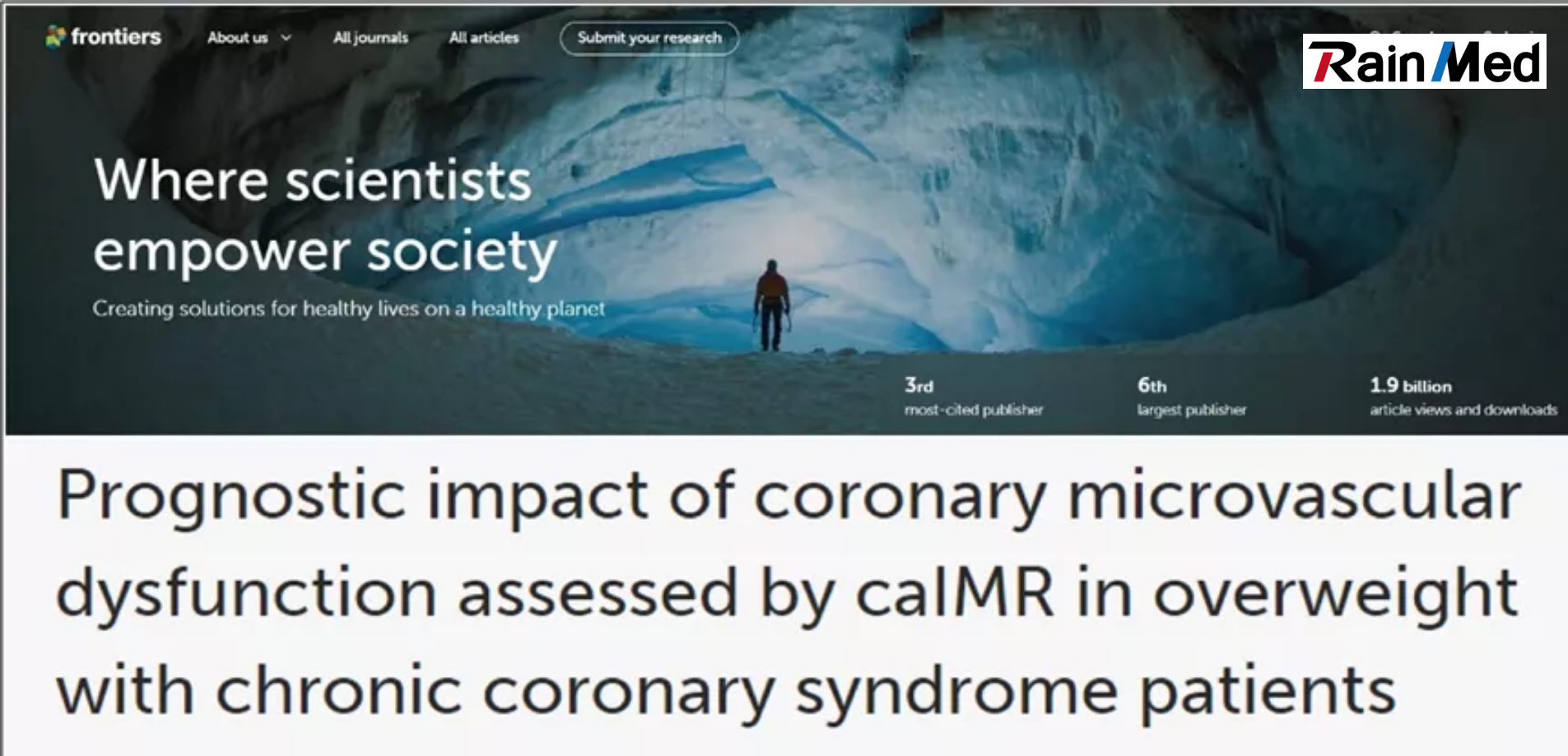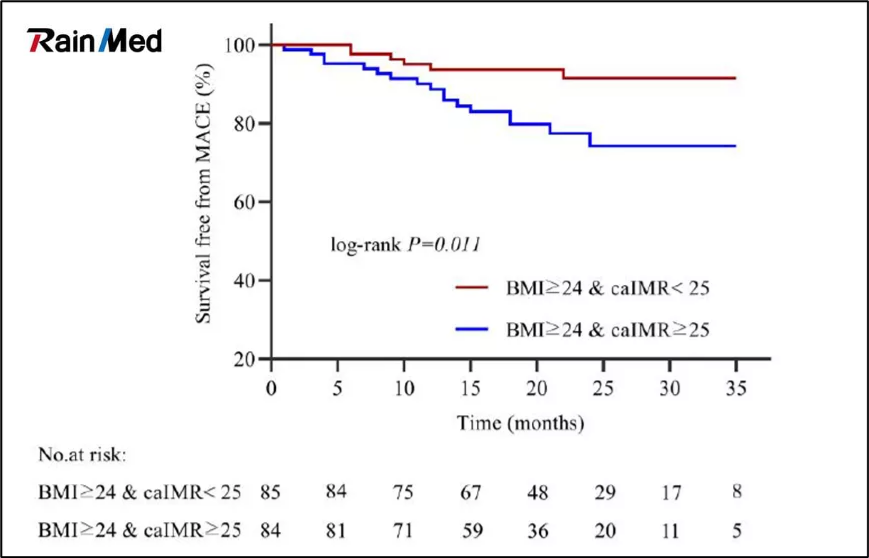New Progress Has Been Made in the Clinical Study of RainMed’s caIMR System: It Can Independently Predict the Prognostic Value of Overweight Patients with Chronic Coronary Syndrome , and Improve the Global Epidemic Management Level
- Categories:Investor Relations
- Author:
- Origin:
- Time of issue:2022-12-16 20:56
- Views:
(Summary description)Recently, a team from Tenth People’s Hospital of Tongji University published a clinical research paper -- "Prognostic impact of coronary microvascular dysfunction assessed by caIMR in overweight with chronic coronary syndrome patients" in an internationally renowned SCI journal. It is a groundbreaking study on the impact of coronary microvascular dysfunction in patients with overweight and chronic coronary syndrome (CCS). Results show that as the world's first non-interventional microcirculatory function diagnostic product, RainMed’s caIMR is an independent predictor of MACE in overweight patients with CCS which offers objective risk stratification for obese patients. This conclusion broadens the clinical application scenario of caIMR system, helps promote the process of epidemic management in China, and creates a new opportunity for large-scale clinical application of caIMR.
New Progress Has Been Made in the Clinical Study of RainMed’s caIMR System: It Can Independently Predict the Prognostic Value of Overweight Patients with Chronic Coronary Syndrome , and Improve the Global Epidemic Management Level
(Summary description)Recently, a team from Tenth People’s Hospital of Tongji University published a clinical research paper -- "Prognostic impact of coronary microvascular dysfunction assessed by caIMR in overweight with chronic coronary syndrome patients" in an internationally renowned SCI journal. It is a groundbreaking study on the impact of coronary microvascular dysfunction in patients with overweight and chronic coronary syndrome (CCS). Results show that as the world's first non-interventional microcirculatory function diagnostic product, RainMed’s caIMR is an independent predictor of MACE in overweight patients with CCS which offers objective risk stratification for obese patients. This conclusion broadens the clinical application scenario of caIMR system, helps promote the process of epidemic management in China, and creates a new opportunity for large-scale clinical application of caIMR.
- Categories:Investor Relations
- Author:
- Origin:
- Time of issue:2022-12-16 20:56
- Views:
Recently, a team from Tenth People’s Hospital of Tongji University published a clinical research paper -- "Prognostic impact of coronary microvascular dysfunction assessed by caIMR in overweight with chronic coronary syndrome patients" in an internationally renowned SCI journal. It is a groundbreaking study on the impact of coronary microvascular dysfunction in patients with overweight and chronic coronary syndrome (CCS). Results show that as the world's first non-interventional microcirculatory function diagnostic product, RainMed’s caIMR is an independent predictor of MACE in overweight patients with CCS which offers objective risk stratification for obese patients. This conclusion broadens the clinical application scenario of caIMR system, helps promote the process of epidemic management in China, and creates a new opportunity for large-scale clinical application of caIMR.

Obesity is one of the ongoing epidemics worldwide. The Global Burden of Disease group estimated that about 4 million deaths worldwide were related to high body mass index (BMI). As a risk factor for myocardial ischemia and increased cardiovascular risk, coronary microcirculation dysfunctions are more common in obese people. Previous studies have revealed that there is a certain correlation between obesity, coronary microcirculation dysfunction and MACE. Through rigorous experimental design, this study first used non-interventional IMR measurement products to measure IMR and analyze patients, and further explored the specific relationship between obesity, coronary microcirculation dysfunction and MACE, providing potential diagnostic indicators for disease risk management of obese patients. The study was published in the journal Frontiers in Endocrinology.
282 CCS patients were enrolled. Among these, 169 (59.93%) were overweight (Overweight was defined as BMI≥24.0kg/m²). A total of 312 stenotic epicardial arteries were measured using RainMed’s caIMR system to diagnose their coronary microcirculation. caIMR=25 was defined as the cut-off value, and caIMR≥25 as coronary microcirculation dysfunction. During the study, patients were followed for an average of 35 months. The results showed that:
1. Patients with coronary microcirculation dysfunction are more likely to have MACE and is common in obese patients. Among the total CCS population, MACE was higher in patients with high caIMR than in low caIMR (18.11% vs. 6.45%, P=0.003). Impaired coronary microvascular function was higher in overweight patients than in patients with normal weight (49.70% vs. 38.05%; P=0.035). During 35 months of follow-up, 33 MACE had occurred.

2. caIMR showed a significant predictive value for adverse outcomes in overweight patients and provided an incremental prediction when added to a prediction model with BMI. Data showed that among obese patients, MACE was higher in overweight patients with high caIMR than low caIMR (20.24% vs. 7.06%, P=0.014), while there were no signifificant differences in normal-weight patients. The ROC curve analysis showed that caIMR could provide a signifificant predictive value for MACE in patients with overweight. And the results showed that caIMR, when added to a model with BMI, the combined model was able to predict adverse outcomes.

Several clinical studies investigated the role of caIMR and concluded that caIMR is a valuable predictor and has a high diagnostic performance in different clinical settings, including coronary artery disease patients who received the percutaneous coronary intervention (PCI), STSegment elevation myocardial infarction (STEMI), and nonobstructive coronary arteries. Notably, there have been no investigations into the prognostic value of the IMR either invasively or non-invasively in obese patients.
This study evaluates the prognostic value of overweight patients with chronic coronary syndrome by using non-invasive and non-pressure guidewire caIMR system, which clarifies the influence of coronary microvascular function measured by caIMR system on the prognosis of overweight patients with chronic coronary syndrome. The study not only expands the clinical indications of the caIMR system, but also provides new potential management tools for the management of chronic diseases that Chinese people suffering from, and pushes forward the prevention and control of vascular diseases and risk factors.
RainMed’s caIMR System is a pioneering coronary microcirculation functional diagnosis product independently developed by RainMed Medical. It is the first non-interventional coronary functional diagnosis system which provides a diagnostic opportunity for clinical complex coronary disease. Meanwhile, as the core product of RainMed’s FlashBot digital functional diagnosis module, caIMR system will be integrated into the FlashBot together with the commercialized caFFR system to assist the robot system to achieve more intelligent and precise diagnosis and treatment, and therefore better empower doctors and benefit patients.
CONTACT US
0512-62622215
Address: Building 31, Northeast District, Nano City, No. 99 Jinji Lake Avenue, Suzhou industrial park
E-mail: market@rainmed.com

WeChat public account

Recruitment QR Code
Page Copyright© 2021- Suzhou Rainmed Medical Technology Co., Ltd. 苏公网安备32059002003601号 (苏)-非经营性-2021-0149


